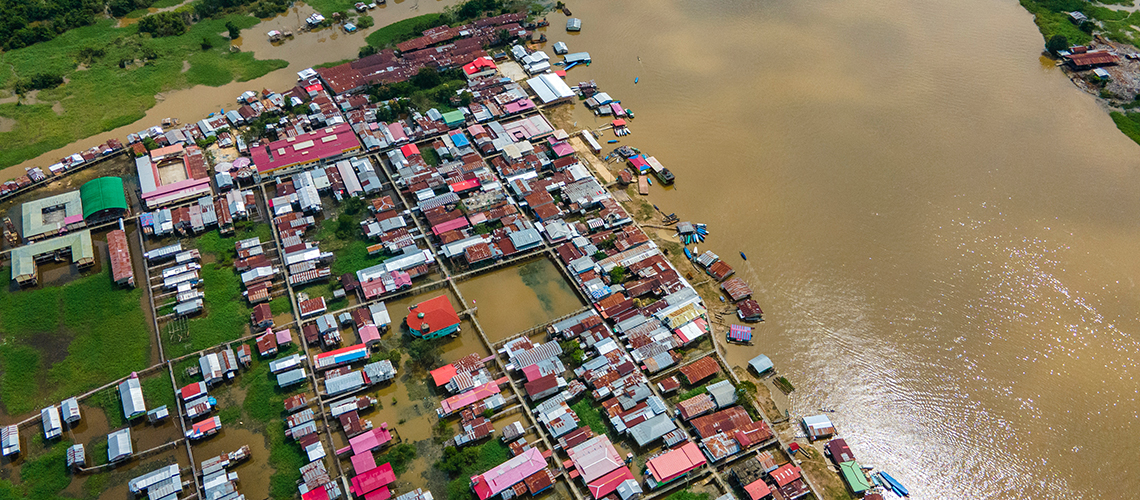 Aerial View of a Riverfront Community in the Amazon Rainforest of Colombia. © Jhampier / Adobe Stock / World Bank.
Aerial View of a Riverfront Community in the Amazon Rainforest of Colombia. © Jhampier / Adobe Stock / World Bank.
Flooding is a recurrent natural hazard in Latin America and the Caribbean, with serious consequences for lives, livelihoods, and infrastructure. In the past twenty-five years, 196 flood events have been reported in Chile, Colombia, Mexico, and Peru combined, affecting over 20 million people, causing almost 4,000 deaths and damage totaling almost US$15.2 billion, according to the EM-DAT database.
Acknowledging the scale of this threat, the four Pacific Alliance countries joined forces to develop new flood modelling tools to better manage flood risk.
How vulnerable might the Pacific Alliance be to flood losses?
New model results integrate climate, geographical and socioeconomic data. They show that the combined flood losses that Chile, Colombia, Mexico, and Peru are estimated to see each year on average is over US$11 billion under current climate conditions. This average annual loss (AAL) goes up to over US$26 billion in a scenario of 2-degree Celsius global warming and reaches over US$36 billion in a 3-degree Celsius global warming scenario.
There are significant variation in the average flood losses experienced by each country; from US$1.88 billion in Chile, to US$4.39 billion in Mexico. Average losses depend on both climate and weather patterns specific to each country as well as the value of a country’s assets and the degree to which they are exposed to floods. Within each country, capital cities and other economic hubs tend to incur greater losses.
Global warming is set to increase losses in Colombia, Mexico, and Peru. Colombia and Peru could experience particularly large increases in average loss. In Colombia, average loss is around US$3 billion under current climate conditions but jumps to over US$18 billion in a 3-degree warming scenario. For Peru average loss goes from US$1.91 billion under current conditions but rises to over US$8.08 billion in a 3-degree warming scenario. Chile is the only exception with a slight decrease in average annual loss under global warming scenarios - likely due to the high climate variability within the country’s regions, some seeing increased risk, whilst others may see decreases.
Figure 1: Average Annual Loss by Country in US$, Billions, for Each Climate Scenario Modeled
Source: World Bank staff figure, based on data from the JBA Risk Management flood modelling
Taking action to combat flood threats
Paradoxically, whilst countries see their economy weaken, they also need sources of finance to speed recovery and strengthen of defences against future threat. To access finance, Chile, Colombia, Mexico, and Peru are proactively managing their public finances to put in place ways to fund these activities. Financial instruments which are set up before an event occurs, such as insurance, contingent credit, reserve funds, and contingency budgets can allow cash to be accessed more promptly than relying on ways to gather funds from zero after an event (e.g. donor funding).
Figure 2: Availability of Disaster Financing Instruments over Time

Source: World Bank staff figure
The results of this new modelling, together with the World Bank report, Managing the Financial Impacts of Flood Risk in the Pacific Alliance, will support countries in developing more effective disaster risk financing solutions. The results not only allow countries to estimate their average national flood losses, but also show how these losses vary across regions —highlighting areas that may need stronger defence actions. In addition, the study show the probability of national flood losses reaching a certain level (indicating how likely it is that current sources of funding would not be sufficient, and how much additional funding might be required). These results can be used alongside other country level information (local market conditions, institutional capacity) to decide what solutions are most appropriate.
“Layering risk”
By using a range of different financial instruments, countries can tailor risk management so that it is adequate and timely while also being affordable and sustainable over the long term. A recommended approach for financing recovery and reconstruction is the use of a “risk-layering” strategy. This strategy manages risk associated with infrequent, high-severity events by transferring it to the financial market, while retaining risk associated with frequent, low-severity events within the country - explore the World Bank Group’s publication, Disaster Risk Finance: A Primer Core Principles and Operational Framework.
Steps ahead
The Pacific Alliance, are continuing to collaborate on strengthening the new modelling to increase its use in future, whilst also discussing how best to manage the financial flood risk highlighted by results. In some cases, a collective approach to the insurance market may be desirable to help bring down average premiums. Any solution developed should be complemented by country-level activities to strengthen risk-reduction efforts and increase public asset insurance.
This work contributes to building resilience within the Pacific Alliance countries. The World Bank Climate Strategy prioritizes adaptation and resilience, recognizing that climate change impacts threaten development progress and economic growth.
This work also provides knowledge to inform country decisions regarding flood risk management; contributing to combatting the climate challenges highlighted in recent country development reports for Colombia and Peru.




Join the Conversation